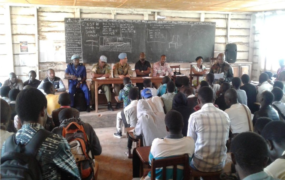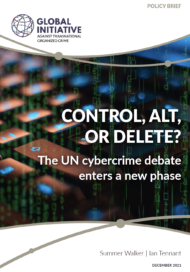Negotiations on the Global Compact for Migration will be held at the UN headquarters in May. David Donoghue, a co-facilitator during negotiations around the 2016 New York Declaration, considers whether it will be able to address the challenges facing migrants and refugees.
GI: Why did human smuggling and trafficking become such important priorities in the refugee and migrant compact processes? Did member states share the same views on the issue?
DD: It was inevitable that issues around human smuggling and trafficking would feature prominently in the negotiations that led to the New York Declaration for Refugees and Migrants (NYD). The 2016 UN summit, which issued the declaration, had been charged with considering the challenges posed by large movements of refugees and migrants. Member states made it clear that they considered human smuggling and trafficking to be among the worst abuses faced by refugees and migrants, and hence the NYD contains references to the particular vulnerabilities of these groups. It would be fair to say that there was very broad agreement on these issues.
In the declaration, member states show their clear determination to eliminate these evil practices. At the outset, it notes that refugees and migrants often face desperate ordeals. Among the various forms of abuse and exploitation they suffer, some feel compelled to employ the services of criminal groups, including smugglers; others may fall prey to such groups or become victims of trafficking.
Among the regional initiatives that have been taken to address such vulnerability and suffering, the declaration draws attention to the African Union–Horn of Africa Initiative on Human Trafficking and Smuggling of Migrants. It recognizes the special needs of people in vulnerable situations who form part of large movements, highlighting, for example, victims of human trafficking and victims of exploitation and abuse in the context of migrant smuggling. And the NYD recognizes the particular vulnerabilities of women and children, including their potential exposure to human trafficking and contemporary forms of slavery.
The declaration also reaffirms the importance of the UN Convention against Transnational Organized Crime and its two relevant protocols, encouraging ratification of, accession to and implementation of certain international instruments on preventing and combating trafficking in persons and the smuggling of migrants.
Recognizing that refugees and migrants in large movements are at risk of being trafficked and of being subjected to forced labour, member states pledged to vigorously combat human trafficking and migrant smuggling with a view to their elimination, including through targeted measures to identify victims of human trafficking or those at risk of trafficking. It also promises support for victims of trafficking. Member states said they would work to prevent human trafficking among those affected by displacement, and the declaration promises a range of collaborative actions to this end.
In short, the powerful messaging on human smuggling and trafficking contained in the NYD reflects the depth of concern that had been expressed by member states during the negotiations, which I co-facilitated.
GI: There are many existing international agreements that address migration and refugee rights, including the UNTOC protocols on migrant smuggling and human trafficking. How do the global compacts seek to add to existing agreements, and what role might instruments such as the UNTOC protocols play within the global compacts?
DD: It is important to note that the two global compacts arising from the NYD (the Global Compact on Refugees and the Global Compact for Safe, Orderly and Regular Migration) will possibly have the same status as the declaration – namely, they will have political force and impact but will not be legally binding agreements. This is the general expectation at present. Of course, commitments made in the compacts could be interpreted differently by the courts in various jurisdictions and one cannot exclude the possibility that they could, over time, acquire a normative value in some states. Even if the compacts are not themselves legally binding, though, it is possible that reference will be made in them to existing agreements on migration and refugee rights, including the UNTOC protocols, and that, as in the NYD, the compacts will emphasize how important it is that as many member states as possible sign up to such agreements.
GI: In the thematic sessions hosted in Geneva and Vienna, which have discussed trafficking and smuggling of migrants, certain key issues have been highlighted by expert panellists:
- The conflation in general discourse of ‘migrant smuggling’ and ‘human trafficking’.
- Panellists have argued that, in many instances, states aiming to curb migration have introduced counterproductive policies that have actually served to make migrants more vulnerable to exploitation.
- It was argued that more insight into smuggling networks is needed, as separate from the trafficking discussion, as smugglers often influence and amplify future migrant flows.
How would you respond to these three comments? Do you feel that they are appropriately and adequately raised in the member states’ deliberations?
DD: On the point about a conflation of migrant smuggling and human trafficking, I agree that there are important distinctions to be made here. In the NYD negotiations, we were conscious of these and did our best to avoid conflating the two terms. I was glad that two distinct sessions formed part of the thematic session in Vienna in September 2017.
The point about some states introducing policies that are counterproductive in terms of protecting migrants from exploitation is important: much greater protection is needed for the rights of trafficking victims. There are real risks of re-victimization or re-trafficking as a consequence of certain counter-trafficking measures.
The role of transnational smuggling networks deserves to be highlighted, along with the importance of coordinated cross-border action, involving both state and non-state actors, to combat them.
GI: Looking ahead, what do you see emerging from the global compact negotiations? Are you confident in the success of the process and if you were to identify key issues that need to be addressed, what would these be?
DD: The co-facilitators of the Global Compact on Migration process will have a vast amount of ground to cover and will also have to contend with high expectations on the part of civil society – as well as a degree of apprehension and defensiveness on the part of many member states. It will not be an easy task to produce a draft capable of attracting broad support. I would like to see a compact that does not reproduce the general analysis already contained in the NYD and other agreements but focuses instead on a range of action points, ideally setting up specific work processes to develop agreements on individual issues. It is clear that the Global Compact on Migration cannot be the last word on all these issues, and that was never the intention. Among the more difficult challenges will be the issue of returnees, the extent to which detention of unaccompanied minors is permissible and how to exert greater impact in terms of deterring migrant smugglers and human traffickers.
The Global Compact on Refugees involves a consultation between the UN High Commissioner for Refugees (UNHCR) and member states, as opposed to a collective negotiation. It will consist of the Comprehensive Refugee Response Framework, which was annexed to the NYD, and an accompanying plan of action. Key challenges here will be how to put into practice the concept of responsibility sharing in the context of refugee emergencies (a concept that is, in any event, not universally agreed upon among member states) and what degree of additional support should be provided for persons in need of protection but who do not qualify under the terms of the 1951 Refugee Convention.
Lastly, the issue of complementarity is an important but thorny one. It is obvious that, to ensure that no issues fall by the wayside (where they are not neatly attributable to either of the compacts), there should be maximum transparency and coordination between the two processes. The problem here is that some member states and regional groups view with suspicion any attempts to link the two – they want to keep a very clear focus on the Global Compact on Migration, whose time has finally come, as they would see it, after decades during which the UN addressed refugee interests comprehensively but has done very little in support of migrants. Some tensions between the International Organization for Migration and the UNHCR compound these suspicions. It will be important therefore to establish clearly the issues that should be common to both compacts and to ensure that they are adequately treated in both.
Muchas cuestiones por cubrir en el próximo pacto mundial
Las negociaciones para el Pacto Mundial para la Migración serán celebradas en la sede de la ONU en mayo. David Donoghue, co-facilitador durante las negociaciones que dieron lugar a la Declaración de Nueva York de 2016, reflexiona sobre si podrá abordar los retos a los que se enfrentan migrantes y refugiados.
GI: ¿Por qué el tráfico de migrantes y la trata de personas se convirtieron en una prioridad tan importante en los procesos que dieron lugar al pacto sobre migrantes y refugiados? ¿Compartían los Estados Miembros la misma postura sobre este tema?
DD: Era inevitable que cualquier asunto en torno al tráfico ilícito y la trata de personas tomara prominencia en las negociaciones que llevaron a la Declaración de Nueva York para los Refugiados y los Migrantes (DNY). La cumbre de la ONU de 2016, en la que se emitió la declaración, había asumido la tarea de considerar los desafíos que plantean los grandes desplazamientos de refugiados y migrantes. Los Estados Miembros dejaron en claro que consideran la trata y el tráfico ilícito de personas entre los peores abusos a los que se exponen los refugiados y migrantes y, por tanto, la DNY hace referencia a las vulnerabilidades particulares de estos grupos. Puede decirse que hubo un amplio consenso sobre estos asuntos.
En la declaración, los Estados Miembros muestran una determinación clara a eliminar estas prácticas perversas. Desde el principio, menciona que los refugiados y los migrantes a menudo enfrentan un calvario desesperado. Entre las varias formas de abuso y explotación que sufren, algunos se sienten obligados a recurrir a los servicios de grupos delictivos, incluyendo al de traficantes; otros pueden caer en manos de esos grupos o convertirse en víctimas de la trata.
Entre las iniciativas regionales que han sido consideradas para abordar estas vulnerabilidades y sufrimientos, la Declaración toma nota de la Iniciativa del Cuerno de África sobre la Trata de Personas y el Tráfico Ilícito de Migrantes. Reconoce las necesidades especiales de las personas en situaciones vulnerables que forman parte de grandes movimientos, y subraya, por ejemplo, las víctimas de la trata de personas y las víctimas de la explotación sexual y el abuso en el contexto del tráfico ilícito de migrantes. Y la DNY reconoce la especial vulnerabilidad de las mujeres y los niños por su exposición potencial a la trata y a formas contemporáneas de esclavitud.
La Declaración también reafirma la importancia de la Convención de la ONU contra la Delincuencia Organizada Transnacional y sus dos protocolos relevantes, alentando la ratificación, el consentimiento y la implementación de ciertos instrumentos internacionales para prevenir y combatir la trata de personas y el tráfico ilícito de migrantes.
Reconociendo que los migrantes y refugiados que forman parte de grandes desplazamientos están expuestos a la trata y al trabajo forzado, los Estados Miembros prometieron combatir enérgicamente la trata de personas y el tráfico ilícito de migrantes con miras a su eliminación, incluyendo la adopción de medidas para identificar a las víctimas o potenciales víctimas de la trata. También se comprometieron a brindar apoyo a las víctimas de la trata, a trabajar para evitar situaciones de trata entre los desplazados, y a tomar una serie de acciones colaborativas con este fin.
En conclusión, el fuerte mensaje sobre el tráfico ilícito de migrantes y la trata de personas contenido en la DNY refleja en profundidad la preocupación que fue expresada por los Estados Miembros durante las negociaciones, en las que fui co-facilitador.
GI: Existen muchos acuerdos internacionales que abordan los derechos de los migrantes y los refugiados, incluyendo los protocolos de la UNTOC sobre tráfico ilícito de migrantes y la trata de personas. ¿De qué manera buscan agregar valor los pactos mundiales a los acuerdos existentes?, y ¿cuál puede ser el rol de instrumentos como los protocolos de la UNTOC dentro de los pactos mundiales?
DD: Es importante mencionar que los dos pactos mundiales que surgen de la DNY (el Pacto Mundial sobre Refugiados y el Pacto Mundial para una Migración Segura, Ordenada y Regular) tienen posiblemente el mismo status que la declaración – es decir, tendrán fuerza e impacto político pero no serán jurídicamente vinculantes. Esa es la expectativa general ahora. Claro que los compromisos asumidos en los pactos podrían tener una interpretación diferente en los tribunales de distintas jurisdicciones y no puede excluirse la posibilidad de que, con el tiempo, puedan adquirir un carácter normativo en algunos Estados. Pero incluso si los pactos no son jurídicamente vinculantes, es posible que en ellos se haga referencia a acuerdos existentes sobre los derechos de los migrantes y refugiados, incluyendo los protocolos de la UNTOC, y que, al igual que en la Declaración de Nueva York, hagan énfasis en la importancia de que los acuerdos sean suscritos por la mayor cantidad posible de Estados.
GI: En las sesiones temáticas celebradas en Ginebra y Viena, en donde se debatió sobre la trata y el tráfico ilícito de migrantes, hubo aspectos que fueron resaltados por panelistas expertos:
- La fusión en el discurso general del “tráfico ilícito de migrantes” y la “trata de personas”.
- Los panelistas argumentaron que, en muchos casos, los Estados que buscan contener la migración han adoptado políticas contraproducentes que, en realidad, solo han puesto a los migrantes ante un riesgo mayor de explotación.
- Se señaló que se necesita más información sobre las redes de tráfico ilícito, separado del debate sobre la trata, ya que los traficantes suelen influir y amplificar los flujos migratorios futuros.
¿Cómo respondería a estos comentarios? ¿Siente que están planteados adecuadamente dentro del debate?
DD: Con respecto a la fusión del tráfico ilícito de migrantes y la trata de personas, concuerdo en que aquí hay que hacer diferencias importantes. En las negociaciones para la DNY, éramos conscientes de esto e hicimos todo lo posible para evitar fusionar los dos términos. En este sentido, estoy contento de que se hayan realizado dos sesiones distintas dentro de la sesión temática en Viena en septiembre de 2017.
Es importante el punto sobre que algunos Estados están adoptando políticas contraproducentes para proteger a los migrantes de la explotación: los derechos de las víctimas de la trata necesitan de una mayor protección. Existen riesgos reales de volver a ser víctimas o de volver a ser traficados ilegalmente como consecuencia de ciertas medidas que se toman contra la trata.
El papel de las redes transnacionales de tráfico ilícito merece ser resaltado, como también la importancia de tomar acciones transfronterizas coordinadas para combatirlas, que involucren tanto a actores estatales como no estatales.
GI: En miras al futuro, ¿qué cree que surgirá de las negociaciones de cara al pacto mundial? ¿Confía en el éxito del proceso? Y, si tuviera que identificar los principales asuntos que deben abordarse, ¿cuáles serían?
DD: Los co-facilitadores del proceso hacia el Pacto Mundial para la Migración tendrán muchas cuestiones por cubrir; deberán enfrentarse tanto a las altas expectativas de la sociedad civil como también a un grado de aprehensión y cierta actitud defensiva por parte de muchos Estados Miembros. No será una tarea fácil producir un borrador capaz de atraer un apoyo amplio. Me gustaría que el pacto no reproduzca el análisis general que ya existe en la DNY y en otros acuerdos, sino que se enfoque en una serie de acciones que, idealmente, planteen procesos específicos de trabajo para entablar acuerdos sobre asuntos individuales. Está claro que el Pacto Mundial para la Migración no puede tener la última palabra en todos estos temas, y nunca fue esa la intención. Entre los desafíos más difíciles estarán: las personas que deciden regresar a casa, hasta qué punto es permisible la detención de menores no acompañados, y cómo lograr un mayor impacto para disuadir a los traficantes de migrantes y a los tratantes.
El Pacto Mundial sobre los Refugiados comprende un proceso de consultas entre el Alto Comisionado de la ONU para los Refugiados (UNHCR/ACNUR) y los Estados Miembros, en contraposición a una negociación colectiva. Consistirá del Marco de Respuesta Integral para los Refugiados, que fue anexado a la DNY, y de un plan de acción. Los principales desafíos aquí serán cómo poner en práctica el concepto de compartir responsabilidades en el contexto de emergencias en materia de refugiados (un concepto que no ha sido acordado universalmente entre los Estados Miembros), y cuál es el nivel de asistencia adicional que se les debería brindar a las personas que necesitan protección pero que no califican como refugiados bajo los términos de la Convención sobre el Estatuto de los Refugiados de 1951.
Por último, el tema de la complementariedad es importante pero polémico. Es obvio que, para garantizar que no quede ningún punto en el camino (que no pueda atribuirse claramente a ninguno de los pactos), debería haber total transparencia y coordinación entre los dos procesos. El problema con esto es que algunos Estados Miembros y grupos regionales ven con sospecha cualquier intento de vincularlos – quieren mantener un foco muy claro sobre el Pacto Mundial para la Migración, al cual por fin le llegó la hora luego de décadas durante las cuales la ONU trató ampliamente los intereses de los refugiados pero que poco hizo en apoyo a los migrantes. Existen algunas tensiones entre la Organización Internacional para las Migraciones y la ACNUR que agravan estas sospechas. Será menester, entonces, establecer claramente los temas que deberían ser comunes a ambos pactos y garantizar que sean tratados adecuadamente en ambos.



